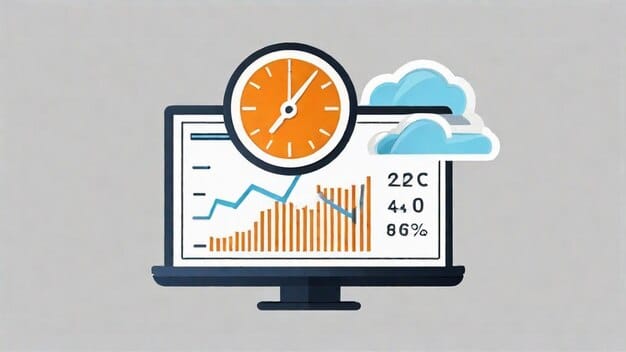Don’t Let Slow Load Times Ruin Your Customer Experience: Optimize Your Website

Don’t Let Slow Load Times Ruin Your Customer Experience: Optimize Your Website for Speed and Performance is crucial to retaining customers and boosting conversions. Addressing issues like large image files, excessive plugins, and unoptimized code can significantly enhance website loading times and overall performance.
In today’s fast-paced digital world, patience is a rare commodity. Website visitors expect instant gratification, and if your site lags, they’ll bounce faster than you can say “page speed.” Don’t Let Slow Load Times Ruin Your Customer Experience: Optimize Your Website for Speed and Performance is not just a technical suggestion; it’s about securing your bottom line and ensuring customer satisfaction.
Imagine a potential customer clicking on your link, eager to explore your offerings, only to be met with a blank screen and a perpetually spinning loading icon. Frustration mounts, and they’re likely to head straight to your competitor. Let’s delve into how you can prevent this scenario and ensure lightning-fast website performance.
Why Website Speed Matters for Customer Experience
Website speed isn’t just a technical metric; it’s a cornerstone of customer experience. A slow website can lead to frustrated users, abandoned shopping carts, and a negative perception of your brand. Understanding the impact of load times is the first step in prioritizing optimization.
The Impact of Slow Loading Times
Studies have repeatedly shown that even slight delays in page load times can have significant consequences. Google, for example, has found that 53% of mobile site visitors leave a page that takes longer than three seconds to load. This highlights the importance of optimizing your website to meet user expectations.
- Increased Bounce Rate: Visitors quickly lose interest if a site takes too long to load, leading to a high bounce rate.
- Lower Conversion Rates: Slow sites frustrate users, deterring them from completing purchases or filling out forms.
- Damaged Brand Reputation: A slow website can make your business seem unprofessional and unreliable.
- Poor Search Engine Ranking: Search engines favor fast-loading websites, impacting your visibility in search results.
Therefore, to Don’t Let Slow Load Times Ruin Your Customer Experience: Optimize Your Website for Speed and Performance, remember website speed isn’t just about technology—it’s about creating a seamless and enjoyable digital experience for your visitors.

How to Measure Your Website’s Speed
Before addressing speed issues, you need to know where your website stands. Several tools are available to help you measure your website’s performance and identify areas for improvement. Regularly monitoring your site’s speed is crucial for maintaining a positive customer experience.
Popular Website Speed Testing Tools
Many free and paid tools can provide valuable insights into your website’s speed and performance. These tools often offer suggestions for improving load times and overall site health.
- Google PageSpeed Insights: This tool analyzes your page’s speed and provides recommendations for optimization.
- GTmetrix: A comprehensive tool that offers detailed performance reports and insights into various aspects of your website’s speed.
- WebPageTest: A more advanced tool that allows you to test your website from different locations and browsers.
Using these tools to gauge your website’s speed can help prevent situations where Don’t Let Slow Load Times Ruin Your Customer Experience: Optimize Your Website for Speed and Performance is a significant problem.
Optimize Images for Faster Loading Times
Images often constitute a significant portion of a website’s file size, making image optimization essential for faster loading times. Using the correct image formats and compression techniques can drastically reduce file sizes without sacrificing visual quality. Prioritizing image optimization can significantly improve your website’s speed.
Techniques for Image Optimization
Several techniques can compress and optimize images, ensuring they load quickly without losing quality. Implementing these strategies can significantly improve your website’s performance.
- Choose the Right Format: Use JPEG for photographs, PNG for graphics with transparency, and WebP for superior compression.
- Compress Images: Use tools like TinyPNG or ImageOptim to reduce file sizes without significant quality loss.
- Resize Images: Ensure images are appropriately sized for their display area to avoid loading unnecessarily large files.
- Lazy Loading: Implement lazy loading to load images only when they come into the viewport, improving initial page load time.
Employing these methods to Don’t Let Slow Load Times Ruin Your Customer Experience: Optimize Your Website for Speed and Performance means creating a visually appealing and efficiently loading website.
Minify CSS, JavaScript, and HTML
Minifying your website’s code—specifically CSS, JavaScript, and HTML—is another critical step in improving loading times. Minification involves removing unnecessary characters from your code, such as whitespace and comments, without affecting its functionality. This reduces file sizes, leading to faster loading and a better user experience.
The Benefits of Code Minification
By reducing the size of your code files, you decrease the amount of data that needs to be transferred over the network, resulting in faster page loading. Minification can also improve code readability for browsers, helping them render your website more efficiently.
- Reduced File Sizes: Minification removes unnecessary characters, reducing the overall size of your code files.
- Faster Load Times: Smaller files transfer more quickly, improving the speed at which your website loads.
- Improved Browser Rendering: Minified code can be easier for browsers to parse, leading to more efficient rendering.
Minifying your codebase is an effective strategy to Don’t Let Slow Load Times Ruin Your Customer Experience: Optimize Your Website for Speed and Performance, giving your site visitors a smoother, quicker experience.

Leverage Browser Caching
Browser caching is a technique that allows web browsers to store static assets of your website, such as images, CSS files, and JavaScript files, on the user’s device. When a user revisits your website, the browser can retrieve these assets from the local cache instead of downloading them again from the server, significantly reducing loading times.
How Browser Caching Works
When a user visits your site, the browser downloads various assets. With proper caching configurations, these assets are stored on the user’s device. Subsequent visits then load these assets from the cache, leading to faster load times.
- Reduced Server Load: Caching reduces the number of requests to your server, decreasing server load.
- Faster Load Times: Users experience significantly faster loading times on repeat visits.
- Improved User Experience: Quick loading enhances the overall user experience, decreasing bounce rates.
To Don’t Let Slow Load Times Ruin Your Customer Experience: Optimize Your Website for Speed and Performance, properly configure browser caching to provide a smoother and quicker experience for returning visitors.
Choose a Fast Hosting Provider
Your hosting provider plays a crucial role in your website’s speed and performance. A reliable hosting provider ensures your website has adequate resources to handle traffic spikes and deliver content quickly. Selecting the right hosting solution can significantly impact your site’s loading times and overall stability.
Different Types of Hosting
Various hosting options are available, each with its own advantages and disadvantages. Understanding these options can help you select the best hosting solution for your website’s needs.
- Shared Hosting: Cost-effective but can be slower due to shared resources.
- VPS Hosting: Offers more resources and better performance than shared hosting.
- Dedicated Hosting: Provides dedicated server resources, offering the best performance and control.
- Cloud Hosting: Scalable and reliable, using a network of virtual servers.
Selecting a fast and reliable hosting provider is essential to Don’t Let Slow Load Times Ruin Your Customer Experience: Optimize Your Website for Speed and Performance, ensuring your site is always responsive and available.
| Key Point | Brief Description |
|---|---|
| ⚡ Optimize Images | Reduce image file sizes to improve page load times. |
| 🚀 Minify Code | Remove unnecessary characters from CSS, JS, and HTML. |
| 🌐 Browser Caching | Leverage caching to store static assets on users’ devices. |
| 🗄️ Fast Hosting | Choose a reliable hosting provider for optimal performance. |
Frequently Asked Questions
Website speed significantly impacts user satisfaction. Slow sites can lead to frustration, increased bounce rates, and reduced conversions, making Don’t Let Slow Load Times Ruin Your Customer Experience: Optimize Your Website for Speed and Performance a priority.
You can measure your website’s speed using tools like Google PageSpeed Insights, GTmetrix, or WebPageTest. These tools provide insights into your site’s performance and offer suggestions for improvement.
Key techniques include choosing the right image format (JPEG, PNG, WebP), compressing images using tools like TinyPNG, resizing images appropriately, and implementing lazy loading.
Minifying code reduces file sizes by removing unnecessary characters, leading to faster load times and improved browser rendering. This can greatly enhance your website’s performance.
Browser caching allows browsers to store static assets on the user’s device, reducing the need to download them on repeat visits, resulting in faster loading times and a better user experience. Using this technique is a key element in Don’t Let Slow Load Times Ruin Your Customer Experience: Optimize Your Website for Speed and Performance.
Conclusion
In summary, proactively addressing website speed is essential for creating a positive customer experience. From optimizing images and minifying code to leveraging browser caching and choosing a reliable hosting provider, each step contributes to faster loading times and increased user satisfaction.
Remember, a fast website not only delights your visitors but also enhances your brand reputation and boosts your search engine rankings. By implementing these strategies, you can Don’t Let Slow Load Times Ruin Your Customer Experience: Optimize Your Website for Speed and Performance, ensuring your online presence is both engaging and efficient.





